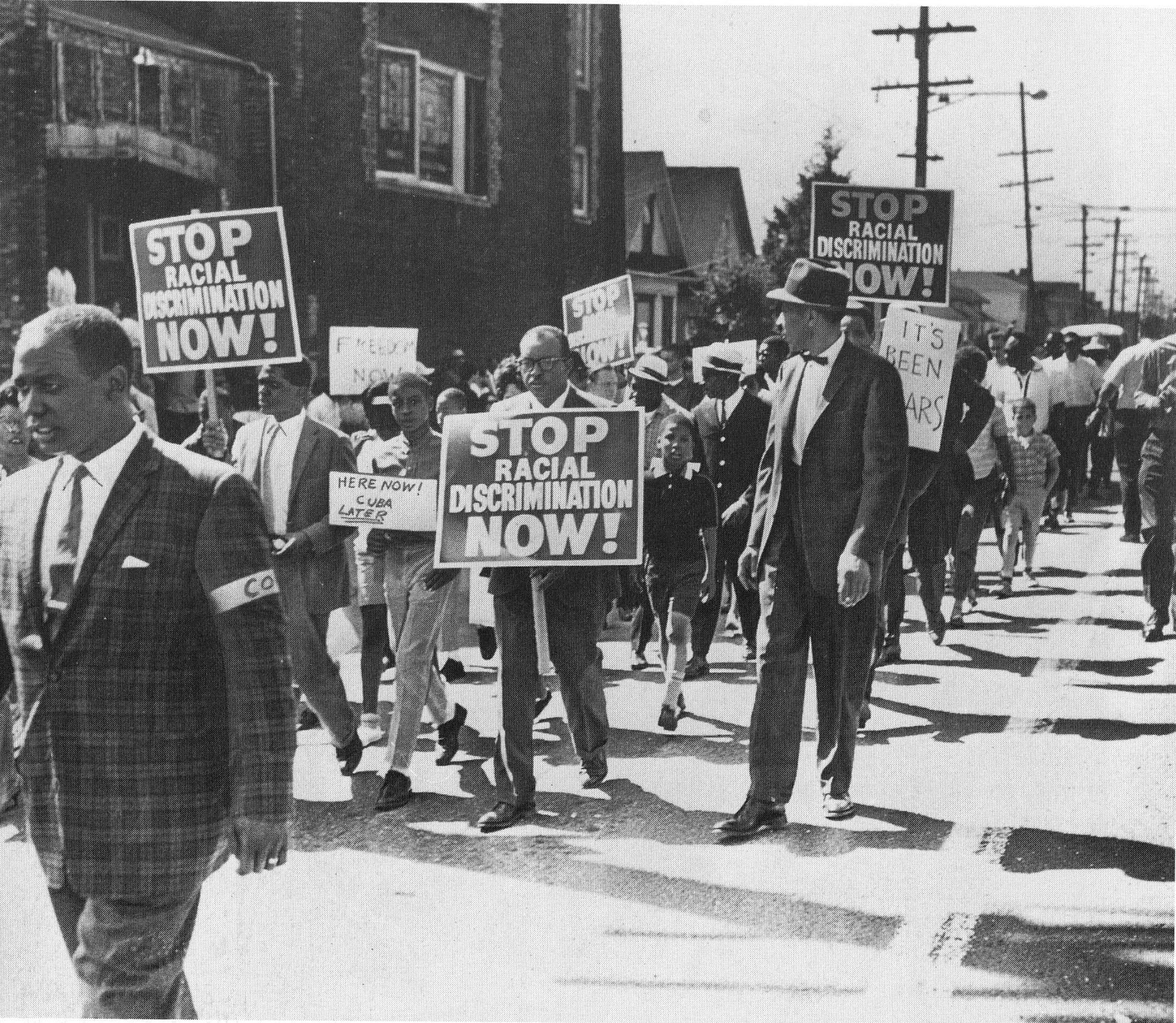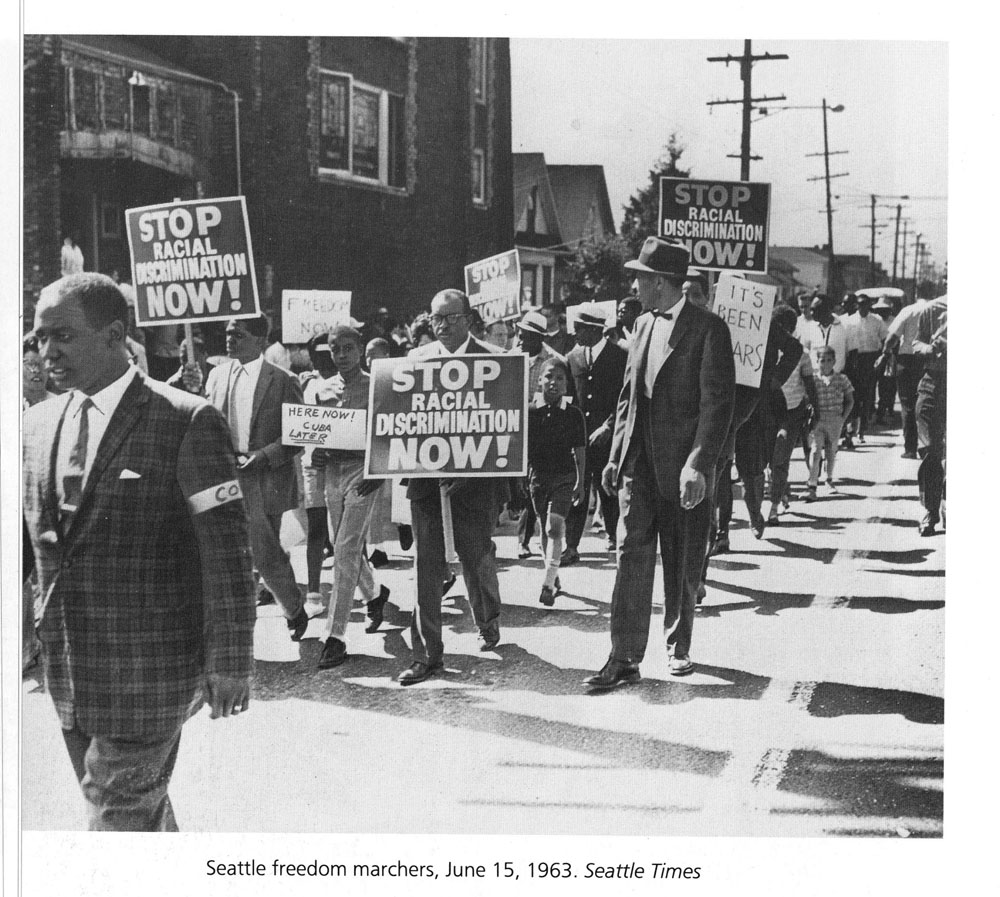Seattle in Black and White


Top of page photo credits: Seattle Post-Intelligencer photograph.
Seattle CORE and civil rights activists worked on a number of problems in addition to employment, housing, schools, and support for activists in the South. One regular challenge—among the first concerns CORE had considered undertaking—was police brutality. The black community had to deal with hostile police behavior repeatedly. How could CORE confront and end such violence? This article by CORE member Sue D. Gottfried, published in 1965, describes an attempt to address the problem.
Seattle in Black and White Authors' Note: This article ends optimistically. Despite significant improvements in police procedures over the years, however, excessive force by police officers still angers the black community. In the summer of 2008, for example, the NAACP held hearings in its project "People's Panel on Police Accountability." On May 20, 2008, the Seattle Post-Intelligencer reported, "Blacks were eight times more likely than whites to be arrested for obstruction, and . . . about half of the cases were dismissed by the City Attorney's Office before trial." On July 2, 2008, the Seattle Times reported that a Seattle City Council panel recommended strengthening the civilian review board that oversees police accountability.

Photo credits: Seattle Times original photo has been lost; copy courtesy of Dr. Quintard Taylor.
A new kind of walk for freedom was born in Seattle recently; walking a policeman's beat.
On July 24, [1965] police on the night beat in five Seattle areas began to be trailed by well-identified shadows. The shadows-in male-female teams of two-wore large cardboard badges labeled "Freedom Patrol." After the night's "tour of duty," Freedom Patrol members trudged the stairs to the offices of Seattle's Congress of Racial Equality (CORE), host and service arm to the project but not its sponsor, to make written reports on police conduct.
The immediate provocation that led to the formation of the Freedom Patrol was the fatal shooting of a Negro, Robert L. Reese, by off-duty Seattle policeman Harold J. Larsen in a tavern brawl on June 20. Because the killing was allegedly a racial incident, raising serious questions about police practices, the Washington chapter of the American Civil Liberties Union urged a grand jury investigation. In a public statement, the chairman of Seattle CORE called for establishment of a permanent police review board. Public officials did not respond to these suggestions. After a coroner's inquest made a finding of "excusable homicide," Larsen, and Patrolman Franklyn Junell, also involved in the brawl, were suspended for thirty days by Police Chief Frank C. Ramon for their "failure . . . to handle a police action in accordance with their training, experience, and departmental procedures." Chief Ramon also announced that he was acceding to the jury's recommendation that policemen not be armed when engaged in off-duty social activities.
That, presumably, was that.
But this disposition of the case aroused outraged feelings in the Negro community and among whites concerned with social justice. Their distrust of the Seattle police and frustration with the deafness of public officials to appeals for corrective measures had been ripening over at least a decade. As long ago as 1956, a citizens' investigating committee appointed by the mayor had recommended establishment of a civilian police review board. This recommendation was never acted upon. As recently as early 1965, when a series of public hearings produced abundant testimony alleging police brutality, the mayor and the city council were still unmoved to take any action whatever.
On July 10, a few days after the coroner's inquest, Seattle's Central Area Council on Civil Rights-a nine-man team of civil rights leaders-called a public meeting to plan protest action. The meeting organized itself into a "Citizens Committee on Police Practices." Goals of the group-to be sought on the legal front as well as through direct action-included investigation of the Reese case by a Federal or county grand jury, and the calling in of a high-level outside agency for study and analysis of police training and performance.
It was at this meeting that the concept of the Freedom Patrol was first broached, to an audience of about 500 Negroes and Caucasians. The purpose of the Freedom Patrol was described as that of documenting police misconduct through observation of police on their beats, and a check on bookings and charges at the city jail, in an effort to bring about official action to correct discriminatory practices.
The Freedom Patrol idea was received with excitement and enthusiasm by those present, although it was evident at this early stage that the exact mode of operation for these "walking citizen review boards" was still far from clear.
Over the ensuing two weeks, a steering committee worked with civil rights leaders and advisers to plan for the effective use and control of the Freedom Patrol. A legal memorandum relating to citizen police-surveillance and records-investigation was drawn up by the ACLU; careful procedures for screening Patrol applicants were worked out; a strict nonviolent discipline was developed; and training sessions were planned. These preparations were, of necessity, experimental, and more hurried than some of the planners would have wished. The first patrol to hit the streets was a highly selective group, including such figures as the ministers of the two leading Negro congregations, one of them the chairman of the Central Area Council on Civil Rights; the president of Seattle NAACP; the vice president of Seattle CORE; the executive secretary of Seattle Urban League; and the executive minister of the Greater Seattle Council of Churches.
Behind the scene were other volunteers: a director, two assistant directors, a training staff, office staff, attorneys on call, telephone monitors, roving automobile patrols, and captains of the evening. Freedom Patrol members had been instructed to keep police within full view, but not to interfere with police operations. They had been asked not only to avoid "attitudes showing malice" toward police, but even to avoid getting into conversations with them. However, on the first Freedom Patrol tour, the Seattle Times reported that "the patrolling officers chatted frequently and in friendly fashion" with Freedom Patrol members.
Although conversations dwindled after the first night, the surface evenness of Patrol-police relations has continued. Freedom Patrollers have reported incidents of policemen attempting to give them the slip, and of being led by police through such extraordinary terrain as unlighted construction sites; but they have not reported overt challenge by police. It is estimated that ninety-five per cent of Seattle's Negro population is concentrated in the areas covered by the Freedom Patrol. Other races are also represented in these areas. Many of the people, of whatever race, are down-and-outers-unemployed, vagrants, alcoholics, drug addicts, petty traffickers in illegal commodities. Some uneasiness about this population was confessed by the predominately middle-class Negroes and whites of the Freedom Patrol, as they first ventured into such territories as "skid row." But the one impression Freedom Patrollers have come to agree upon is the tolerant-to-friendly-to-warm attitude of the "civilians"-most of who appear to be well informed of the Patrol's mission.
On August 18, four Negro men, who with the deceased Robert Reese had been involved in the June 20 tavern fight, were convicted of assault. The following week, Patrolman Junell was found innocent by a Justice Court of the charge that he provoked the assault by using such derogatory expressions as "nigger." In the course of this trial, it came to light that Assistant Police Chief Charles Rouse and a police sergeant had withheld the names and statements of four witnesses to the tavern altercation. The only results of this disclosure were that the police sergeant was moved to another detail, and Rouse was moved down a notch to the job of deputy chief. No further fuss about the suppression of evidence was made by anyone in public authority. While policemen Larsen, Junell and Rouse settled back into the routine of their ordinary lives, the four convicted Negroes drew sentences which will keep them under alternate incarceration and observation over the coming year.
As may be supposed, these developments failed to reassure critics that justice reigns triumphant in the city of Seattle. The Citizens Committee on Police Practices has intensified its efforts to bring outside pressure to bear, concentrating on signed petitions to the United States Civil Rights Commission to hold hearings.
Complaints of police misconduct, also for forwarding to the U.S. Civil Rights Commission, come mainly through letters, telephone calls, and personal interviews initiated by alleged victims. The Freedom Patrol itself has observed no clear-cut incidents of police misbehavior. Somewhat to the contrary. "They assist the drunks ever so gently into the wagons, then look over their shoulders at us as if to say, 'See? This is how we act all the time,'" said a Patrol member with a wry grin. An attorney who is a member of the Freedom Patrol has remarked that the openness of the Patrols is "not good investigatory technique."
But if its modus operandi does not lend itself to evidence-gathering, the Patrol's open presence may be having other good effects. A police department employee recently told a Freedom Patrol acquaintance that for the first time in his near-decade of service, he had heard a police captain cautioning police about abusive language and behavior toward minority-race citizens. There are reports that arrests have declined in neighborhoods watched by Freedom Patrollers; there are rumors that alleged police-protected illegal business operators have been told to "cool it for a while," with a consequent falling-off in such trades.
The Freedom Patrol is without clear precedent in the annals of nonviolent direct action. In its form, as well as in its ethnic self-consciousness, it bears some resemblance to the "Peace Patrol" of the East Harlem Action Committee, which during the 1964 summer riots in New York succeeded in preventing clashes between helmeted police and Puerto Rican residents. It bears a still fainter resemblance to the voluntary patrols which sought to protect Jewish residents of Brooklyn from hoodlum violence. Perhaps more closely related ancestors of the Freedom Patrol were the "haunting" squads which came into being in the Gandhian movement. The Indian nonviolent campaigners developed a system of following public officials wherever they went, to remind them of the immorality and injustice of their behavior. Indirectly "haunted," Seattle's Mayor J. D. Braman was moved in mid- September to set up a "human relations division" within the police department, for the express purpose of bettering relations between police and minority groups. The mayor's action was the first tacit admission by any city official that police practices could stand improvement.
Although the strength of the Freedom Patrol-originally numbering some fifty-five trained "regulars"-has been roughly halved by familiar processes of erosion, a hard core of volunteers continues to appear on the streets two or three nights a week. Meanwhile the organization of Freedom Patrols in Los Angeles and New Orleans has been reported. The life of this new version of "haunting squads" may only have begun.